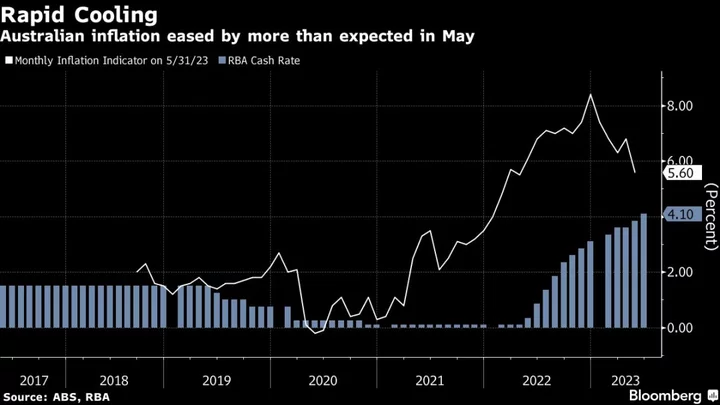Australia’s central bank kept its key interest rate unchanged on Tuesday as the board assesses the economic impact of its more than yearlong tightening cycle, while leaving the door open to future hikes.
The Reserve Bank held its cash rate at 4.1%, its second pause of the year, in a decision predicted by 19 of 32 economists surveyed by Bloomberg. The move will allow the board more time to reflect on the state of the economy, as well as the outlook and associated risks, the RBA said.
“Some further tightening of monetary policy may be required to ensure that inflation returns to target in a reasonable timeframe, but that will depend upon how the economy and inflation evolve,” RBA Governor Philip Lowe said in a post-meeting statement. “The board remains resolute in its determination to return inflation to target and will do what is necessary to achieve that.”
The Australian dollar declined and was trading at 66.50 US cents at 2:42 pm in Sydney, while the rate-sensitive three-year government bond yield also fell, even as the central bank signaled it likely had more work to do.
The decision extends a series of staccato-like policy moves from the RBA: hiking in February and March, pausing in April, raising in May and June and then holding in July as it adjusts to volatile economic data. It contrasts with a more sustained tightening cycles by peers in the US and Europe, whose central bank chiefs recently said they still had ways to go in tamping down inflation.
Lowe has said the RBA is in data-dependent mode as it keeps a close eye on consumer spending, labor costs, business surveys and inflation. While goods inflation and household consumption are showing signs of easing, core prices remain above 6%, well in excess of the bank’s 2-3% target.
“The board remains alert to the risk that expectations of ongoing high inflation will contribute to larger increases in both prices and wages, especially given the limited spare capacity in the economy and the still very low rate of unemployment,” Lowe said in his statement.
An advantage of pausing in July is that the RBA will have the opportunity to study the quarterly inflation report — the most comprehensive catalog of prices — due on July 26. The central bank staff will also deliver updated forecasts in a few weeks.
Tuesday’s pause reflects Lowe’s efforts to bring the economy in for a soft landing while keeping hold of some of the employment gains made during the pandemic. The RBA has raised rates by 4 percentage points compared with 5.25 points by nearby New Zealand and the Federal Reserve’s 5 points.
The long and variable lags associated with monetary policy are another reason the RBA is moving cautiously. The looming expiry of a large number of home loans fixed at record low rates during the pandemic is a cloud on the horizon. Around 90% of fixed mortgages rolling off this year will see repayments increase by 30% or more, RBA research shows.
The decision comes as Treasurer Jim Chalmers is due this month to make an announcement on the next RBA governor, with Lowe’s seven-year term expiring in mid-September. Some observers have warned that a decision to replace Lowe during a tightening cycle may be perceived as political influence, particularly as his two predecessors received extensions.
Underscoring the need for the RBA to move with caution, Australian households are among the most leveraged in the developed world, with a debt-to-income ratio of 188%.
Lowe has acknowledged the path to cooling inflation while preserving employment gains is “narrow,” while reiterating that the bank will do what it takes to bring inflation back to target.
The RBA chief will have an opportunity to further explain the board’s decision and outlook for the economy next week in a speech in Brisbane.
--With assistance from Tomoko Sato.
(Updates with more details.)

